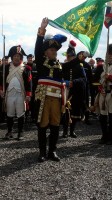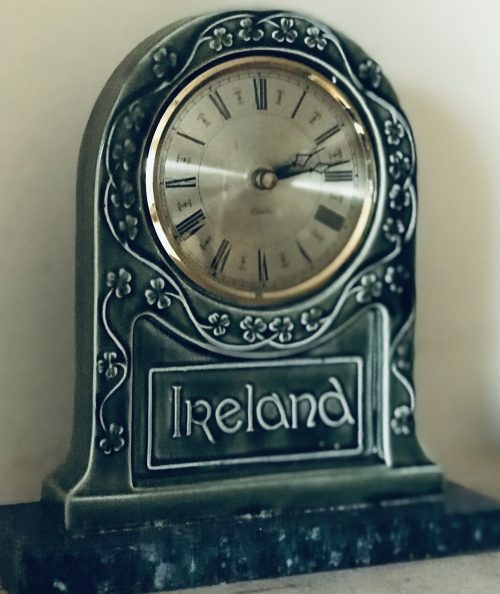| Pos. | Player | Team | Appearances |
|---|---|---|---|
| GK | Tipperary | 2 | |
| RCB | Galway | 2 | |
| FB | Limerick | 1 | |
| LCB | Galway | 1 | |
| RWB | Cork | 2 | |
| CB | Galway | 2 | |
| LWB | Galway | 4 | |
| MD | Offaly | 1 | |
| MD | Waterford | 1 | |
| RWF | Galway | 1 | |
| CF | Cork | 1 | |
| LWF | Offaly | 1 | |
| RCF | Galway | 1 | |
| FF | Limerick | 5 | |
| LCF | Limerick | 3 |
-

 85cm x 45cm Dingle Co Kerry The Gaelic Athletic Association-Gaelic Players' Association All Stars Awards (often known simply as the All Stars) are awarded annually to the best player in each of the 15 playing positions in Gaelic football and hurling. Additionally, one player in each code is selected as Player of the Year. The awards have since 2011 been presented jointly by the Gaelic Athletic Association and the representative body for inter-county players, the Gaelic Players Association. Each player who receives a nomination is given a medallion marking the milestone.These are considered to be "the most coveted sporting award scheme in the country".Since the 1960s there had been a tradition of annually selecting the best player in each position, in football and hurling, to create a special team of the year. Between 1963 and 1967 these players received what was known as the Cú Chulainn award. In 1971 these awards were formalised into the annual GAA All Star Awards. In 2006 the Gaelic Players Association launched a parallel award scheme entitled the GPA Gaelic Team of the Year (often referred to as the GPA Awards). An annual award was also given by the GPA to the Footballer of the Year and the Hurler of the Year. In 2011 it was announced that the GAA All Stars Awards, which had been sponsored in recent years by Vodafone, and the GPA Awards would merge under the sponsorship of car manufacturer Opel. The move announced by Christy Cooney saw the achievements of players recognised jointly for the first time in October 2011. The All Stars team comprises the best player in each position, regardless of club or county affiliation. The composition of the All Star teams are decided on the basis of a shortlist compiled by a selection committee of sports journalists from the national media, while the overall winners are chosen by inter-county players themselves. The award is regarded by players as the highest accolade available to them, due to it being picked by their peers. The awards are presented at a gala banquet in November following the end of the Championship season. Both men's teams are honoured with a special holiday where they play an exhibition game. Since 1971 over 1,000 players have been honoured with All Stars Awards. Damien Martin of Offaly was the first ever recipient of the award, while in 2004 Paul Galvin of Kerry became the 1,000th winner of the award. Carlow and Longford are the only county in Ireland not to receive an award in either sport. In September 2017 PwC became the new sponsors of the All Star Awards on a four year deal, with the awards being re-named The PwC All-Stars.
85cm x 45cm Dingle Co Kerry The Gaelic Athletic Association-Gaelic Players' Association All Stars Awards (often known simply as the All Stars) are awarded annually to the best player in each of the 15 playing positions in Gaelic football and hurling. Additionally, one player in each code is selected as Player of the Year. The awards have since 2011 been presented jointly by the Gaelic Athletic Association and the representative body for inter-county players, the Gaelic Players Association. Each player who receives a nomination is given a medallion marking the milestone.These are considered to be "the most coveted sporting award scheme in the country".Since the 1960s there had been a tradition of annually selecting the best player in each position, in football and hurling, to create a special team of the year. Between 1963 and 1967 these players received what was known as the Cú Chulainn award. In 1971 these awards were formalised into the annual GAA All Star Awards. In 2006 the Gaelic Players Association launched a parallel award scheme entitled the GPA Gaelic Team of the Year (often referred to as the GPA Awards). An annual award was also given by the GPA to the Footballer of the Year and the Hurler of the Year. In 2011 it was announced that the GAA All Stars Awards, which had been sponsored in recent years by Vodafone, and the GPA Awards would merge under the sponsorship of car manufacturer Opel. The move announced by Christy Cooney saw the achievements of players recognised jointly for the first time in October 2011. The All Stars team comprises the best player in each position, regardless of club or county affiliation. The composition of the All Star teams are decided on the basis of a shortlist compiled by a selection committee of sports journalists from the national media, while the overall winners are chosen by inter-county players themselves. The award is regarded by players as the highest accolade available to them, due to it being picked by their peers. The awards are presented at a gala banquet in November following the end of the Championship season. Both men's teams are honoured with a special holiday where they play an exhibition game. Since 1971 over 1,000 players have been honoured with All Stars Awards. Damien Martin of Offaly was the first ever recipient of the award, while in 2004 Paul Galvin of Kerry became the 1,000th winner of the award. Carlow and Longford are the only county in Ireland not to receive an award in either sport. In September 2017 PwC became the new sponsors of the All Star Awards on a four year deal, with the awards being re-named The PwC All-Stars.
F00tball : Charlie Nelligan (Kerry), Harry Keegan (Roscommon), Kevin Kehilly (Cork), Gerry Connellan (Roscommon), Kevin McCabe (Tyrone), Tim Kennelly (Kerry), Danny Murray (Roscommon), Jack O'Shea (Kerry), Colm McKinstry (Armagh), Ger Power (Kerry), Dinny Allen (Cork), Pat Spillane (Kerry), Matt Connor (Offaly), Eoin Liston (Kerry), John Egan (Kerry -
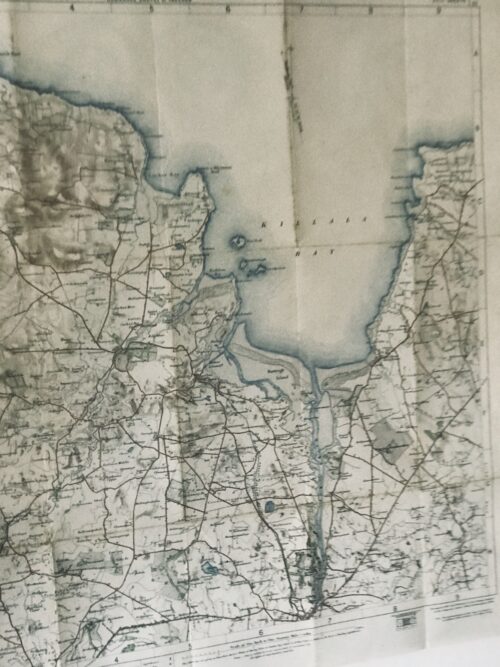
 Original ordnance survey map from 19 of Killala Bay Co Mayo in superb frame. Westport Co Mayo 65cm x 65cm Killala is a quiet seaside resort but the harbour warehouses show that it was once a busy port. This remote little town enjoys a place of disproportionate importance in the history of Ireland, as it was here that the French first halted when they invaded in 1798. The 1798 French invasion of Ireland On August 6, 1798, General Humbert’s “Army of Ireland” set sail from La Rochelle destined for Killala, Co. Mayo …
Original ordnance survey map from 19 of Killala Bay Co Mayo in superb frame. Westport Co Mayo 65cm x 65cm Killala is a quiet seaside resort but the harbour warehouses show that it was once a busy port. This remote little town enjoys a place of disproportionate importance in the history of Ireland, as it was here that the French first halted when they invaded in 1798. The 1798 French invasion of Ireland On August 6, 1798, General Humbert’s “Army of Ireland” set sail from La Rochelle destined for Killala, Co. Mayo …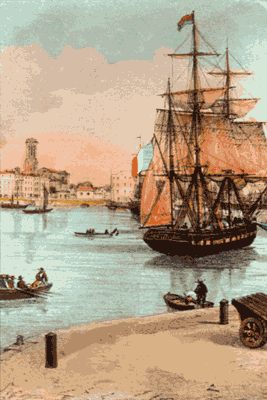
La Rochelle’s harbour.
On July 19, 1798, the French Directory authorises the sending of three expeditions to Ireland and gives command of the first one to General Humbert.
On August 6, 1798, General Humbert’s Army of Ireland sailed from La Rochelle in three frigates La Concorde, La Franchise, La Médée, carrying 1,025 French troops, 3 light field cannons, 3,000 muskets, and 400 sabres.
There were also a number of Irish among Humbert’s command. These included Bartholomew Teeling and Fr. Henry O Kane. This tiny force, together with its Irish allies, was to conduct an extraordinary campaign that shook the British Empire.During 16 days they sailed taking a circuitous route to avoid detection by the British navy. The mission of this little French expeditionary force was to provide military assistance to the Irish rebels of the “Rising of ’98” – sometimes referred to as “Bliadhan na bhFrancach” or “The Year of the French” – in their attempt to free Ireland from English domination.
The fleet had originally planned to land in Co. Donegal, but due to storm and no doubt influenced by the presence of Fr. O Kane who was a native of Killala the fleet sailed into Killala Bay.
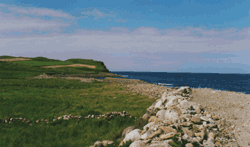
Kilcumminn head, Co. Mayo
On the 22nd of August, 1798, the three frigates landed at Kilcummin flying the English colours.
Edwin and Arthur Stock, sons of the Protestant Bishop of Killala, who had sailed out to meet them, greeted them. The two were captured, the English flag taken down and the French flag hoisted.
One of the first to disembark was Fr. O Kane who spoke to the locals in Irish which was the native tongue of most of the Irish at that time. Word soon filtered to native Irish throughout Mayo and Sligo.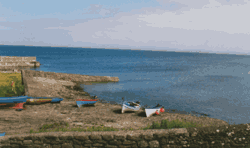
Kilcumminn strand,landing-place of the French
Bishop Stock also heard of the arrival and he sent messages to the local gentry among them the Jacksons, the Knoxs, Binghams, Palmers and Kirkwoods. Into the relative quiescence of northwest Ireland, the French expeditionary force fell like a thunderbolt. By about 7pm the landing was complete.
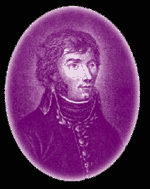
General Humbert
Young Général Jean-Joseph-Amable Humbert (the landing occurred on his 31st birthday), a canny veteran of irregular warfare against the insurgents of the Vendée, was well aware of the odds against him in a conventional military showdown, but also of the multiplying effects of surprise and speed.
He was also keenly aware of the importance of early victory for exciting the morale of the Irish insurgents and dismaying the ill-trained loyalist militia.
The first military confrontation occurred on the afternoon of 22 August, when Colonel Jean Sarrazin led a group of French Grenadiers south to the nearby village of Killala.

Killala, viewed from the north.
The garrison of 200 men included a handful of regulars of the 17th Foot (Leicestershire Regiment), but was mostly composed of the Yeomanry, an ill-trained part-time paramilitary constabulary.
With a portion of Sarrazin’s force circling around the British left flank and the remainder pressing a frontal attack with the bayonet, the unnerved Loyalists fired one ragged volley and then fled in terror towards Ballina.
Three Frenchmen were slightly wounded, bishop Stock’s palace was taken over as Humbert’s H.Q. and several of the yeomen were taken prisoner.

Ireland forever – l’Irlande pour toujours
A French soldier then climbed to the top of the palace and removed the British flag, which was replaced by a green and gold flag bearing the inscription ‘Erin Go Bragh’ (Ireland forever).
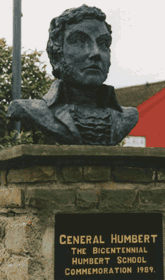
General Humbert statue in Killala.
LIBERTY, EQUALITY, FRATERNITY, UNION “After several unsuccessful attempts behold at last Frenchmen arrived amongst you . . . “Brave Irishmen, our cause is common. Like you we hold as indefeasible the right of all nations to liberty. Like you we are persuaded that the peace of the world shall ever be troubled as long as the British ministry is suffered to make with impunity a traffic of the industry and blood of the people . . . “Union, Liberty, the Irish Republic! Such is our shout. Let us march. Our hearts are devoted to you; our glory is in your happiness.”
From General Humbert’s Proclamation of 22nd August, 1798. (This last sentence of Humbert’s Proclamation became our pub’s motto!)
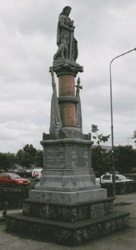
Mémorial de Ballina
This initial humbling of their oppressors had the desired effect on the local population, bringing forward thousands of eager, though ignorant and ill-disciplined Irish volunteers who were hastily equipped and formed into companies. Muskets were issued to some, but as in the uprisings elsewhere in Ireland that year, most of the insurgents were armed with crude pikes, scythes, and hay-forks.
On the 24th of August, having captured Killala, Humbert sent two groups under Sarrazin (provisionally promoted to Général de Brigade by Humbert on 23 August) and Adjudant-General Fontaine to capture Ballina.That night a fight took place between Sarrazin’s troops and the British at Rosserk. The English eventually retreated in confusion. The next morning the French/Irish troops captured Ballina under cover of darkness. The Irish peasants lit bundles of straw to show them their way. This approach road to Ballina has since been known as Bothair na Sop. They took Ballina without much resistance. The English for the most part fled towards Foxford where they would have their forces waiting for the French advance on Castlebar.
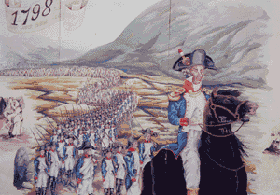
Humbert – Windy Gap Pass
The British commander in County Mayo, General Hutchinson, expected Humbert to continue south along the only decent road out of Ballina toward Castlebar, the commercial and strategic center of the region.
Where the road crosses the River Moy at Foxford, Hutchinson placed a strong blocking force with ample artillery. Clashes of French and British patrols along the Ballina-Foxford road appeared to confirm British expectations.Humbert, closely questioning the locals, learned that there was an alternative route to Castlebar, a barely-practicable goat-trail that ran west of Lough Conn, over the Windy Gap pass, and then south to the town. He resolved to take this route.
To further the deception, the Franco-Irish forces marched out of Ballina along the Foxford road at sunset on August 26 with ostentatious noise and shouted boasts of expected victory at Foxford, then doubled back in silence and darkness to the west of Loch Conn. At midnight, Humbert’s army was in Lahardane.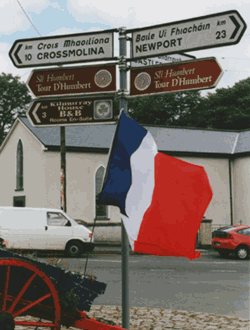
“Tour D’Humbert” signposts in Lahardane
The local priest, Father Andrew Conroy, was fluent in French from his time at seminary in Nantes.
He gave precious directions to the French officers and marshalled the people to provide food and assistance to the troops. In the aftermath of the campaign, Father Conroy was arrested, tried, and executed by the vengeful British.After a rigorous night-march of 40 km (25 miles), Humbert’s 800 French, 600 Irish, and 1 laboriously manhandled gun reached Castlebar on 27 August.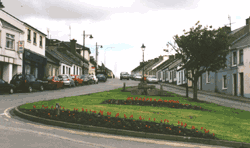
Sion Hill (now built-up)
A yeoman farmer who had been tending to his cattle had spotted the French/Irish advance party. He immediately fled to Castlebar to warn the British commander of the eminent arrival of the French/Irish forces.
The English forces took up position at Sion Hill just outside the town. Humbert approached and took account of the English position.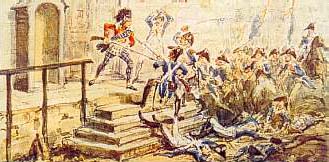
Batlle of Castlebar known as “Races of Castlebar”.
Following a number of attacks in which they were hit by British cannon, Humbert decided to regroup and divided his troops, splitting them to the left and right so as to attack the English flanks. The Irish drove a herd of cattle ahead of them causing confusion in the English rank. The French/Irish made an effective bayonet charge through the centre.
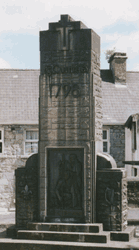
Castlebar Memorial
The English retreated down Staball Hill. Another attack occurred at Main St. Bridge. The English defended the bridge for some time using forces from the Longford and Kilkenny militias and Fraser Fencibles (a Scottish regiment).
There was confused fighting in the town as knots of the more stalwart British, notably the Fraser Fencibles and Roden’s Dragoons, attempted to make a stand.
The bulk of the redcoat forces, abandoning all guns, standards, and baggage, ran in headlong flight down the road to Tuam, 54 km (34 miles) to the southeast; some apparently did not stop until reaching Athlone, a further 68 km (42 miles) away. General Lake’s army being dissolved.
The event has since become mockingly known among the Irish as “The Castlebar Races.” In all the attack only lasted six hours from 6a.m. to 12 noon and has been described by Thomas Pakenham in The Year of Liberty as one of the most ignominious defeats in British military history. Following this brilliant victory, Humbert spent the next few days resting and reorganizing his army, absorbing many hundreds of new Irish volunteers including some 250 deserters from the Longford and Kilkenny Militias.The “Republic of Connaught” was proclaimed and a makeshift revolutionary government installed.Army of Ireland – Liberty, Equality
Head quarters at Castlebar, 14th Fructidor, sixth Year of the French Republic, One and Indivisible. General Humbert, Commander in Chief of the Army of Ireland, desirous of organizing with the least possible delay, an administrative power for the Province of Connaught, decrees as follows:
1. The Government of the Province of Connaught shall reside at Castlebar till further orders. 2. The Government shall be composed of twelve members, who shall be named by the General-in-chief of the French Army. 3. Citizen JOHN MOORE is named President of the Government of the Province of Connaught, he is specially entrusted with the nomination and reunion of the members of the Government. 4. The Government shall occupy itself immediately in organizing the Military power of the Province of Connaught, and with providing subsistence for the French and Irish Armies. 5. There shall be organized eight regiments of infantry, each of twelve hundred men, and four regiments of cavalry, each of six hundred men. 6. The Government shall declare rebels and traitors to the country all those who having received clothing and arms, shall not join the army within four and twenty hours. 7. Every individual from sixteen years of age to forty, inclusive, is REQUIRED in the name of the Irish Republic, to betake himself instantly to the French Camp, to march in a mass against the common enemy. The General Commanding-in-Chief HUMBERT.Lord Cornwallis (the same who had surrendered to Washington at Yorktown), now the Viceroy and Commander-in-Chief in Ireland, moved west from Dublin to take personal command of the campaign.It was obvious that after the fiasco of Castlebar, the Crown forces in Ireland would marshal every possible resource to crush Humbert.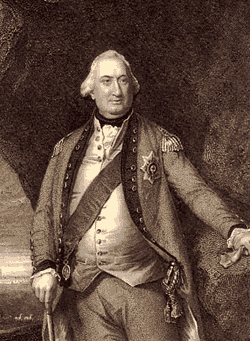
Lord Cornwallis
By the 2nd of September, Cornwallis had 7,800 men, including two reliable Scottish regiments (the Sutherland and Rehy Fencibles) concentrated at Tuam, organized into four brigades under Generals Hunter, Campbell, Hutchinson, and Moore (later the hero of Corunna), and a further 2,800 at Boyle.
Cornwallis advanced from Tuam on the 4th of September, but on arriving at Castlebar on the 5th found only a small Franco-Irish rearguard. Aware of the impossibility of defeating the well-equipped and far more numerous Crown forces, and with no sign of reinforcements from France, Humbert had marched off to the east on 4 September, under cover of darkness, taking his army, now totalling 3,000 men, towards Sligo, covering 58 miles in 36 hours. The long march had begun. Some Irish troops under French officers remained to protect Killala and receive the expected reinforcements.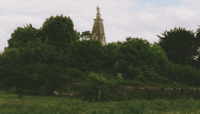
Collooney, Co. Sligo
On the morning of the 5th of September, an English army from Sligo under Col Vereker attacks the Franco-Irish army at Collooney with its left protected by the Ballysadare River and its right anchored on a steep, wooded hill. Humbert again outmanoeuvres them.
In what may be one of the greatest feats of individual bravery in the long history of the Revolutionary and Napoleonic Wars, Colonel Bartholomew Teeling, a United Irishman holding a French commission, galloped forward alone to the British line, pistolled the enemy gunner at point-blank range, and rode back unscathed under a hail of musket-fire. Inspired by his example, the Irish and French surged forward and routed the Loyalists. The English retreated with heavy losses as far as Ballyshannon, County Donegal.Cornwallis has now divided his army in two, one half under General Lake to pursue the enemy and the other half, under his own personal command, to protect the line of the river Shannon.
Ballinamuck pikeman
The French and Irish “must not cross”. Meanwhile, the United Irishmen of Longford and Westmeath have assembled. They capture Wilson’s Hospital near Mullingar but fail to take the town of Granard. Humbert, on hearing of the midlands rising decides to link up with the insurgents there.He is now near Manorhamilton but changes and goes straight for Granard. He abandons some of the heavier guns so as to make more speed. So far he has eluded the cordon closing in around him. With some luck he hopes to slip past the net, reach Granard and then strike for Dublin which is virtually unprotected as most of the garrison have been moved to Connacht. The Franco-Irish army reaches Drumkeerin in the evening of September 6. An envoy from Lord Cornwallis offers terms for surrender but they are rejected.On September 7, shortly before noon Humbert’s army crosses the Shannon at Ballintra Bridge just south of Loch Allen, but they fail in an attempt to demolish the bridge behind them.
His army shows signs of fatigue and skirmishes with the English advance guard become more frequent. The race for Granard quickens.
The Franco-Irish army reaches Cloone, in South Leitrim, while Cornwallis, with 15,000 men is at Mohill, five miles away. Humbert gets news that he is surrounded and outnumbered but decides to push on even if the best he can now do is to make a token resistance before surrender.On September 8, 1798, near the small village of Ballinamuck, County Longford, Humbert drew up his 859 French troops in line of battle. There could be little doubt of the outcome.
Behind Humbert was Cornwallis blocking Humbert’s way to Dublin. In front was Lake’s 6000 men. The battle which lasted but half an hour commenced with Colonel Crawford’s dragoons cutting through the Irish rebels. When the British grand assault poured up the hill from three sides, in overwhelming numbers, Humbert gave the order to surrender.
Humbert surrenders in Ballinamuck
The French officers followed their general’s signal and ordered their men to lay down their muskets. A second body of British cavalry had reined in seeing the signs of surrender, but Colonel Teeling, an Irish officer in the French army, had not signaled surrender so British infantry advanced on them. Crawford attacked a large contingent of Irishmen with his dragoons, their sabres sparing only those with officers insignia, hanging to be their fate.
Later testimonies reveal that on arresting Humbert, General Lake could not conceal his astonishment: “Where is your army?” Lake demanded “This is it all” Humbert replied, indicating his soldiers. “And what were you planning to do with this lot?” Lake asked. “We were going to Dublin to break the irons of a nation that suffers under your yoke” Humbert said. “That is an idea that could only be born in a Frenchman’s brains!” Lake declared.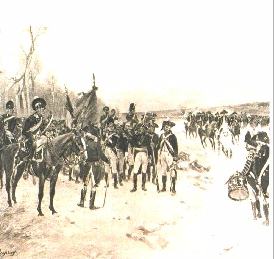
Humbert surrenders in Ballinamuck
Humbert and the French prisoners were conducted to Dublin and treated with all the consideration that could be given to gallant prisoners after an honorable defeat.
Not so the Irish. Accounts vary, but it appears that many of the Irish were cut down where they stood, or driven into the bog south of the hill where they were hunted down and slaughtered. Captured Irish officers, even those bearing legitimate commissions in the French army, were seized and hanged as traitors. Such was Bartholomew Teeling, Matthew Tone and Gunner James Magee’s fate.“After having obtained the greatest successes and made the arms of the French Republic triumph during my stay in Ireland, I have at length been obliged to submit to a superior force of 30,000 troops.” General Humbert’s Report to the French Directory after Ballinamuck.
‘A SHORT BUT VERY FATIGUING CAMPAIGN’
English historians have always treated General Humbert’s expedition to Ireland with ridicule, but Brian O hUiginn was fond of quoting Plowden the military correspondent of the London Times who held a different view. This expert wrote some years ago:
“In these operations described by Cornwallis to the Duke of Portland as a short but very fatiguing campaign, a raiding party of 1000 French landed in Ireland without opposition, after sixteen days of navigation, unobserved by the British Navy; defeated and drove back the British troops opposing them on four separate occasions; routed a force of second line troops of at least double its strength; captured eleven British guns; held the field for seventeen days; entirely occupied the attention of all the available troops of a garrison of Ireland 150,000 strong; penetrated almost to the centre of the island, and compelled the Lord Lieutenant to send an urgent requisition to London for ‘as great a reinforcement as possible.’ “
This was a fine tribute to General Humbert and his troops.- In Humbert’s footsteps 2013 – Killala & Castlebar
- In Humbert’s footsteps 2013 – Killala & Castlebar
- In Humbert’s footsteps 2013 – Killala & Castlebar
- In Humbert’s footsteps 2013 – Killala & Castlebar
The Charentais of the expedition.
Many Charentais took part in the expedition. Among them: Daniel Savary, who was born in Salles sur Mer (17), was in command of the naval division charged with transporting the expedition from La Rochelle to Killala. François Babin, born in Péré (17), became Commander of the Castlebar battalion. Jean Jobit, born in Chateauneuf en Charente (16), was a Commander on the Castlebar battlefield in Castlebar. Jean-Paul Leugerat, born in Barbezières (16), died during the battle of Castlebar. -
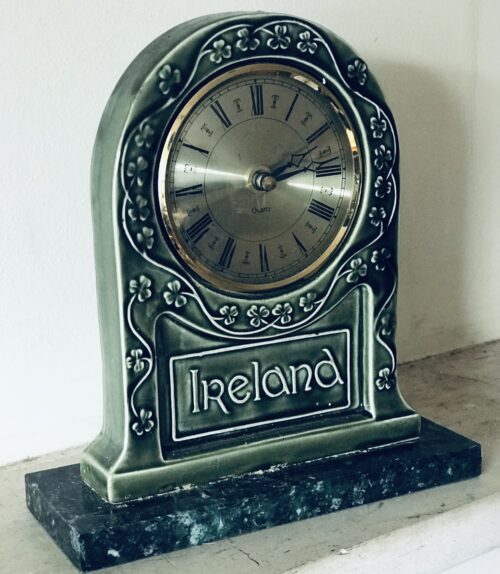
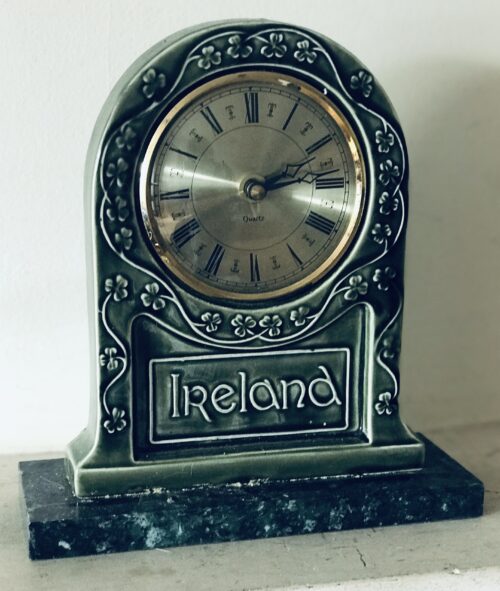 Quaint green ceramic clock with Irish theme,manufactured by Knock Pottery,Co Mayo. 23cm x 22cm x8cm Knock (Irish Cnoc Mhuire, 'Hill of the Virgin Mary') is a major international Catholic pilgrimage and prayer site. On August 21st, 1879, the Virgin Mary, St Joseph and St John the Evangelist, appeared on the south gable of Knock Parish Church. This Apparition was witnessed by fifteen local people, young and old. As a result, Knock became a major Irish pilgrimage site of prayer and worship. In the latter part of the 20th century Knock's popularity increased steadily, making it one of Europe's major Catholic Marian shrines, together with Lourdes and Fatima. Today this shrine is visited by one and a half million pilgrims annually. In 1979, Knock was visited by Pope John Paul II, to commemorate the centenary of the apparition. Mother Teresa of Calcutta visited the Shrine in June 1993 Monsignor James Horan was parish priest of Knock from 1967, until his death in 1986. In that period of his service to the parish of Knock, he accomplished some landmark achievements, amongst them the building of a new basilica in 1976, which can accommodate 10,000 people, and also the construction of Ireland West Airport Knock, which he saw completed in 1985. Monsignor Horan was also instrumental in organising the visit of Pope John Paul II to the shrine in 1979Knock Shrine is open all year round. The main pilgrimage season extends from the last Sunday in April until the second Sunday in October. The clock mechanism in good working order. Origins : Co Mayo Dimensions : 22cm x 21cm 4kg
Quaint green ceramic clock with Irish theme,manufactured by Knock Pottery,Co Mayo. 23cm x 22cm x8cm Knock (Irish Cnoc Mhuire, 'Hill of the Virgin Mary') is a major international Catholic pilgrimage and prayer site. On August 21st, 1879, the Virgin Mary, St Joseph and St John the Evangelist, appeared on the south gable of Knock Parish Church. This Apparition was witnessed by fifteen local people, young and old. As a result, Knock became a major Irish pilgrimage site of prayer and worship. In the latter part of the 20th century Knock's popularity increased steadily, making it one of Europe's major Catholic Marian shrines, together with Lourdes and Fatima. Today this shrine is visited by one and a half million pilgrims annually. In 1979, Knock was visited by Pope John Paul II, to commemorate the centenary of the apparition. Mother Teresa of Calcutta visited the Shrine in June 1993 Monsignor James Horan was parish priest of Knock from 1967, until his death in 1986. In that period of his service to the parish of Knock, he accomplished some landmark achievements, amongst them the building of a new basilica in 1976, which can accommodate 10,000 people, and also the construction of Ireland West Airport Knock, which he saw completed in 1985. Monsignor Horan was also instrumental in organising the visit of Pope John Paul II to the shrine in 1979Knock Shrine is open all year round. The main pilgrimage season extends from the last Sunday in April until the second Sunday in October. The clock mechanism in good working order. Origins : Co Mayo Dimensions : 22cm x 21cm 4kg -

 26cm x 33cm Fantastic shot of the most westerly GAA pitch in Ireland and prob in Western Europe-the pitch on Care Island where the resourceful locals have mangaged to produce a decent playing surface on the only flat patch of land on the island ! Inishturk (Inis Toirc in Irish, meaning Wild Boar Island) is an inhabited island of County Mayo, in Ireland.
26cm x 33cm Fantastic shot of the most westerly GAA pitch in Ireland and prob in Western Europe-the pitch on Care Island where the resourceful locals have mangaged to produce a decent playing surface on the only flat patch of land on the island ! Inishturk (Inis Toirc in Irish, meaning Wild Boar Island) is an inhabited island of County Mayo, in Ireland.Geography
The island lies about 15 km (9 mi) off the coast; its highest point reaches 189.3 m (621.1 ft) above sea level. Between Inisturk and Clare Island lies Caher Island. It has a permanent population of 58 people.There are two main settlements, both on the more sheltered eastern end of the island, Ballyheer and Garranty. Bellavaun and Craggy are abandoned settlements. The British built a Martello tower on the western coast during the Napoleonic Wars. Inisturk has the highest per capita donation rate towards the RNLI in the whole of Ireland.History
Inishturk has been inhabited on and off since 4,000 BCE and has been inhabited permanently since at least 1700. Some of the more recent inhabitants are descended from evacuees from Inishark to the southwest. The social club Mountain Common is situated on the hill that separates the two settlements.Recent history
In 1993 Inishturk Community centre was opened, this community centre doubles as a library and a pub. In June 2014 the ESB commissioned three new Broadcrown BCP 110-50 100kVA diesel generators to supply electricity to the island The ESB have operated a diesel power station on the island since the 1980s Inishturk gained international attention in 2016 after a number of websites claimed that the island would welcome any American "refugees" fleeing a potential Donald Trump presidency.These claims were used as one example of the type of "fake news" that arose during the 2016 US presidential election campaign. As of November 2016, no changes to inward migration have been reported. The island is home to a primary school on the island which in 2011 had only 3 pupils, this believed to be the smallest primary school in IrelandDemographics
The table below reports data on Inisturk's population taken from Discover the Islands of Ireland (Alex Ritsema, Collins Press, 1999) and the Censusof Ireland.Historical population Year Pop. ±% 1841 577 — 1851 174 −69.8% 1861 110 −36.8% 1871 112 +1.8% 1881 116 +3.6% 1891 135 +16.4% 1901 135 +0.0% 1911 132 −2.2% 1926 101 −23.5% Year Pop. ±% 1936 107 +5.9% 1946 125 +16.8% 1951 123 −1.6% 1956 110 −10.6% 1961 108 −1.8% 1966 92 −14.8% 1971 83 −9.8% 1979 85 +2.4% 1981 76 −10.6% Year Pop. ±% 1986 90 +18.4% 1991 78 −13.3% 1996 83 +6.4% 2002 72 −13.3% 2006 58 −19.4% 2011 53 −8.6% 2016 51 −3.8% Source: Central Statistics Office. "CNA17: Population by Off Shore Island, Sex and Year". CSO.ie. Retrieved October 12, 2016. Transport[edit]
Prior to 1997 there was no scheduled ferry service and people traveled to and from the islands using local fishing boats. Since then a ferry service operates from Roonagh Quay, Louisburgh, County Mayo.[13] The pier was constructed during the 1980s by the Irish government, around this time the roads on the island were paved.[14] -
Out of stock
 John Skelton was born in Armagh in 1925. A very talented artist who delighted in portraying the ordinary men and women of Rural Ireland, his works are on permanent display in the Joyce Collection of Northwestern University of Illinois,the headquarters of the ESB,Bank of Ireland and the Embassy of South Korea. Skelton started his professional career in London, where he came under influence of Euston Road School in the late 1940s. In 1946 he married Caroline, settling four years later in Dublin. He worked initially in advertising as Art Director and illustrator of books, most of them educational. After 1975 he worked full-time as a painter. He had numerous one man shows in Dublin; two in Belfast, one in Los Angeles and one in the Mystic Seaport Museum in Connecticut. Up to the late 1980s, Skelton was a frequent exhibitor in group shows, particularly the annual Royal Hibernian Academy and the Watercolour Society shows in Dublin. In recent years, however, his work was in such demand that he contributed to these less often. During the 1970s and earlier 1980s he earned a reputation as a gifted teacher and lecturer in the National College of Art and Design in Dublin. John Skelton's grave can be found at Mount Jerome Cemetery, Harold's Cross, Dublin, Ireland. Origins:Co Mayo Dimensions :29cm x 36cm
John Skelton was born in Armagh in 1925. A very talented artist who delighted in portraying the ordinary men and women of Rural Ireland, his works are on permanent display in the Joyce Collection of Northwestern University of Illinois,the headquarters of the ESB,Bank of Ireland and the Embassy of South Korea. Skelton started his professional career in London, where he came under influence of Euston Road School in the late 1940s. In 1946 he married Caroline, settling four years later in Dublin. He worked initially in advertising as Art Director and illustrator of books, most of them educational. After 1975 he worked full-time as a painter. He had numerous one man shows in Dublin; two in Belfast, one in Los Angeles and one in the Mystic Seaport Museum in Connecticut. Up to the late 1980s, Skelton was a frequent exhibitor in group shows, particularly the annual Royal Hibernian Academy and the Watercolour Society shows in Dublin. In recent years, however, his work was in such demand that he contributed to these less often. During the 1970s and earlier 1980s he earned a reputation as a gifted teacher and lecturer in the National College of Art and Design in Dublin. John Skelton's grave can be found at Mount Jerome Cemetery, Harold's Cross, Dublin, Ireland. Origins:Co Mayo Dimensions :29cm x 36cm -

 Superb Guinness advert publicising their sponsorship of the All Ireland Senior Hurling Championship-unframed print. 44cm x 60cm Guinness were long time sponsors of the All Ireland Senior Hurling Championship.Hurling is an ancient sport ,played for over 2000 years by such mythical Irish legends such as Setanta, who is depicted here in this distinctive Guinness advert fighting off a fierce wolf, armed with just a Hurl and a sliotar! Following on the company’s imaginative marketing and advertising campaigns — with such slogans as ‘Not Men But Giants,’ ‘Nobody Said It Was Going To Be Easy’ and ‘The Stuff of Legend’ — other imaginative adverts brought the message that hurling is part of the Irish DNA. Other campaigns, entitled ‘It’s Alive Inside’ focused on how hurling is an integral part of Irish life and how the love of hurling is alive inside every hurling player and fan.
Superb Guinness advert publicising their sponsorship of the All Ireland Senior Hurling Championship-unframed print. 44cm x 60cm Guinness were long time sponsors of the All Ireland Senior Hurling Championship.Hurling is an ancient sport ,played for over 2000 years by such mythical Irish legends such as Setanta, who is depicted here in this distinctive Guinness advert fighting off a fierce wolf, armed with just a Hurl and a sliotar! Following on the company’s imaginative marketing and advertising campaigns — with such slogans as ‘Not Men But Giants,’ ‘Nobody Said It Was Going To Be Easy’ and ‘The Stuff of Legend’ — other imaginative adverts brought the message that hurling is part of the Irish DNA. Other campaigns, entitled ‘It’s Alive Inside’ focused on how hurling is an integral part of Irish life and how the love of hurling is alive inside every hurling player and fan. -

 Superb Guinness advert publicising their sponsorship of the All Ireland Senior Hurling Championship. 62cm x 84cm Guinness were long time sponsors of the All Ireland Senior Hurling Championship.Hurling is an ancient sport ,played for over 2000 years by such mythical Irish legends such as Setanta, who is depicted here in this distinctive Guinness advert fighting off a fierce wolf, armed with just a Hurl and a sliotar! Following on the company’s imaginative marketing and advertising campaigns — with such slogans as ‘Not Men But Giants,’ ‘Nobody Said It Was Going To Be Easy’ and ‘The Stuff of Legend’ — other imaginative adverts brought the message that hurling is part of the Irish DNA. Other campaigns, entitled ‘It’s Alive Inside’ focused on how hurling is an integral part of Irish life and how the love of hurling is alive inside every hurling player and fan.
Superb Guinness advert publicising their sponsorship of the All Ireland Senior Hurling Championship. 62cm x 84cm Guinness were long time sponsors of the All Ireland Senior Hurling Championship.Hurling is an ancient sport ,played for over 2000 years by such mythical Irish legends such as Setanta, who is depicted here in this distinctive Guinness advert fighting off a fierce wolf, armed with just a Hurl and a sliotar! Following on the company’s imaginative marketing and advertising campaigns — with such slogans as ‘Not Men But Giants,’ ‘Nobody Said It Was Going To Be Easy’ and ‘The Stuff of Legend’ — other imaginative adverts brought the message that hurling is part of the Irish DNA. Other campaigns, entitled ‘It’s Alive Inside’ focused on how hurling is an integral part of Irish life and how the love of hurling is alive inside every hurling player and fan. -
 36cm x 29cm The An Post GAA Hurling Team of the Millennium was chosen in 2000 to comprise, as a fifteen-member side divided as one goalkeeper, three full-backs, three half-backs, two midfielders, three half-forwards and three full-forwards, the best hurling team of all-time. The team, announced by GAA President Seán McCague on 24 July 2000 at a special function in Croke Park, was selected by a special committee, comprising five past GAA presidents - Joe McDonagh, Con Murphy, Paddy Buggy, Pat Fanning and Séamus Ó Riain - as well as GAA director-general Liam Mulvihill and four Gaelic games journalists: Paddy Downey, Mick Dunne, Seán Óg Ó Ceallacháin and Jim O'Sullivan. The initiative was sponsored by An Post, who issued special commemorative stamps of the millennium team members.
36cm x 29cm The An Post GAA Hurling Team of the Millennium was chosen in 2000 to comprise, as a fifteen-member side divided as one goalkeeper, three full-backs, three half-backs, two midfielders, three half-forwards and three full-forwards, the best hurling team of all-time. The team, announced by GAA President Seán McCague on 24 July 2000 at a special function in Croke Park, was selected by a special committee, comprising five past GAA presidents - Joe McDonagh, Con Murphy, Paddy Buggy, Pat Fanning and Séamus Ó Riain - as well as GAA director-general Liam Mulvihill and four Gaelic games journalists: Paddy Downey, Mick Dunne, Seán Óg Ó Ceallacháin and Jim O'Sullivan. The initiative was sponsored by An Post, who issued special commemorative stamps of the millennium team members.Controversy
While universal agreement on such a team would prove impossible, the selection committee came in for some criticism regarding omissions and changes from the earlier GAA Hurling Team of the Century. Kilkenny's D. J. Carey was seen as a shock omission from the team. As the holder of a then record seven All-Stars, Carey, whose inter-county career began in 1989, was seen as one of the greatest goal-scorers of his era and was hotly tipped to get one of the half-forward spots for which he was nominated. The 1990s were regarded as a golden age of hurling with many new teams emerging, however, this was not reflected in the team. Clare's Brian Lohan had been tipped for full-back but Wexford's Nick O'Donnell held on. There were no places for any of the Clare team that emerged to win two championships in the nineties. Brian Whelehan was the only player from the previous 20 years to make the team. An absence of players from Galway also sparked off major controversy in that county where the selection committee were accused of belittling the county by not recognising any of its heroes. There was anger too in Wexford over the dropping of full-forward Nicky Rackard from the Team of the Century. Former midfielder Dave Bernie, who won an All-Ireland medal in 1968, when Rackard was a selector, said Wexford fans were stunned by the news he had not been included. -

 Nostalgic,atmospheric photo of Pope John Paul II arriving at Dublin Airport in 1979 on board an Aer Lingus 747-it was the first time a Pope had visited Ireland . 66cm x 56cm Gort Co Galway Pope John Paul visited Ireland from Saturday 29 September to Monday, 1 October 1979, the first trip to Ireland by a pope. Over 2.5 million people attended events in Dublin, Drogheda, Clonmacnoise, Galway, Knock, Limerick, and Maynooth. It was one of John Paul's first foreign visits as Pope, who had been elected in October 1978. The visit marked the centenary of the reputed apparitions at the Shrine of Knock in August 1 1878. An Aer Lingus Boeing 747, named St Patrick, brought Pope John Paul II from Rome to Dublin Airport. The Pope kissed the ground as he disembarked. After being greeted by the President of Ireland Patrick Hillery, the Pope flew by helicopter to Phoenix Park where he celebrated Mass for 1,250,000 people, one third of the population of the Republic of Ireland. Afterwards he travelled to Killineer, near Drogheda, where he led a Liturgy of the Word for 300,000 people, many from Northern Ireland. There the Pope appealed to the men of violence: "on my knees I beg you to turn away from the path of violence and return to the ways of peace". The Pope had hoped to visit Armagh, but the security situation in Northern Ireland rendered it impossible. Drogheda was selected as an alternative venue as it is situated in the Catholic Archdiocese of Armagh. Returning to Dublin that evening, the Pope was greeted by 750,000 people as he travelled in an open top popemobile through the city centre and visited Áras an Uachtaráin, the residence of the Irish President.His final engagement was a meeting with journalists at the Dominican Convent in Cabra.The journalists from the international media broke into a spontaneous rendition of 'For he's a jolly good fellow' when the Pope arrived. Pope John Paul spent the night at the nearby Apostolic Nunciature on the Navan Road in Cabra. Pope John Paul began the second day of his tour with a short visit to the ancient monastery at Clonmacnoise in County Offaly.With 20,000 in attendance, he spoke of how the ruins were "still charged with a great mission".Later that morning he celebrated a Youth Mass for 300,000 at Ballybrit Racecourse in Galway. It was here that the Pope uttered perhaps the most memorable line of his visit: "Young people of Ireland, I love you".That afternoon, he travelled by helicopter to Knock Shrine in County Mayo which he described as "the goal of my journey to Ireland".The outdoor Mass at the shrine was attended by 450,000. The Pope met with the sick and elevated the church to the title of Basilica. He lit a candle at the Gable Wall for the families of Ireland. Monsignor James Horan, instrumental in the shrine's development, welcomed the Pope to Knock. The final day of the visit began with a brief early morning visit to St Patrick's College, Maynooth, the National Seminary, in County Kildare.Some 80,000 people joined 1,000 seminarians on the grounds of the college for the brief visit. A dense fog delayed the Pope's arrival from Dublin by helicopter. The final Mass of the Pope's visit to Ireland was celebrated at Greenpark Racecoursein Limerick before 400,000 people, many more than had been expected. The Mass was offered for the people of Munster. Pope John Paul left Ireland from nearby Shannon Airport travelling to Boston where he began a six-day tour of the United States. Pope John Paul delivered 22 homilies and addresses during the course of this visit, including a televised message for the sick broadcast on RTÉ on the evening of his arrival in Ireland. Audio files of his more significant speeches are preserved on the website of the Irish Catholic Bishops Conference.Many of the temporary fixtures and ornaments at the public masses were auctioned two months after the visit to help defray its cost. A Time Remembered - The Visit of Pope John Paul II to Ireland was produced by RTÉ in 2005. Many children were named John and Paul in the aftermath of the papal visit. There were many Johns and Pauls beforehand but there was a huge increase in the amount of children called after the Pope's taken names. Some children were also given both names as their Christian name and were known as John Paul in honour of the Pope's visit.
Nostalgic,atmospheric photo of Pope John Paul II arriving at Dublin Airport in 1979 on board an Aer Lingus 747-it was the first time a Pope had visited Ireland . 66cm x 56cm Gort Co Galway Pope John Paul visited Ireland from Saturday 29 September to Monday, 1 October 1979, the first trip to Ireland by a pope. Over 2.5 million people attended events in Dublin, Drogheda, Clonmacnoise, Galway, Knock, Limerick, and Maynooth. It was one of John Paul's first foreign visits as Pope, who had been elected in October 1978. The visit marked the centenary of the reputed apparitions at the Shrine of Knock in August 1 1878. An Aer Lingus Boeing 747, named St Patrick, brought Pope John Paul II from Rome to Dublin Airport. The Pope kissed the ground as he disembarked. After being greeted by the President of Ireland Patrick Hillery, the Pope flew by helicopter to Phoenix Park where he celebrated Mass for 1,250,000 people, one third of the population of the Republic of Ireland. Afterwards he travelled to Killineer, near Drogheda, where he led a Liturgy of the Word for 300,000 people, many from Northern Ireland. There the Pope appealed to the men of violence: "on my knees I beg you to turn away from the path of violence and return to the ways of peace". The Pope had hoped to visit Armagh, but the security situation in Northern Ireland rendered it impossible. Drogheda was selected as an alternative venue as it is situated in the Catholic Archdiocese of Armagh. Returning to Dublin that evening, the Pope was greeted by 750,000 people as he travelled in an open top popemobile through the city centre and visited Áras an Uachtaráin, the residence of the Irish President.His final engagement was a meeting with journalists at the Dominican Convent in Cabra.The journalists from the international media broke into a spontaneous rendition of 'For he's a jolly good fellow' when the Pope arrived. Pope John Paul spent the night at the nearby Apostolic Nunciature on the Navan Road in Cabra. Pope John Paul began the second day of his tour with a short visit to the ancient monastery at Clonmacnoise in County Offaly.With 20,000 in attendance, he spoke of how the ruins were "still charged with a great mission".Later that morning he celebrated a Youth Mass for 300,000 at Ballybrit Racecourse in Galway. It was here that the Pope uttered perhaps the most memorable line of his visit: "Young people of Ireland, I love you".That afternoon, he travelled by helicopter to Knock Shrine in County Mayo which he described as "the goal of my journey to Ireland".The outdoor Mass at the shrine was attended by 450,000. The Pope met with the sick and elevated the church to the title of Basilica. He lit a candle at the Gable Wall for the families of Ireland. Monsignor James Horan, instrumental in the shrine's development, welcomed the Pope to Knock. The final day of the visit began with a brief early morning visit to St Patrick's College, Maynooth, the National Seminary, in County Kildare.Some 80,000 people joined 1,000 seminarians on the grounds of the college for the brief visit. A dense fog delayed the Pope's arrival from Dublin by helicopter. The final Mass of the Pope's visit to Ireland was celebrated at Greenpark Racecoursein Limerick before 400,000 people, many more than had been expected. The Mass was offered for the people of Munster. Pope John Paul left Ireland from nearby Shannon Airport travelling to Boston where he began a six-day tour of the United States. Pope John Paul delivered 22 homilies and addresses during the course of this visit, including a televised message for the sick broadcast on RTÉ on the evening of his arrival in Ireland. Audio files of his more significant speeches are preserved on the website of the Irish Catholic Bishops Conference.Many of the temporary fixtures and ornaments at the public masses were auctioned two months after the visit to help defray its cost. A Time Remembered - The Visit of Pope John Paul II to Ireland was produced by RTÉ in 2005. Many children were named John and Paul in the aftermath of the papal visit. There were many Johns and Pauls beforehand but there was a huge increase in the amount of children called after the Pope's taken names. Some children were also given both names as their Christian name and were known as John Paul in honour of the Pope's visit. -
 Huge Guinness All Ireland Hurling championship unframed advertisement from the first year of sponsorship in 1995. 38cm wide x 150cm long . It was not until 1994 that the GAA decided that the football championship would benefit from bringing on a title sponsor in Bank of Ireland. Although an equivalent offer had been on the table for the hurling championship, Central Council pushed the plate away.Though the name of the potential sponsor wasn’t explicitly made public, everyone knew it was Guinness. More to the point, everyone knew why Central Council wouldn’t bite. As Mulvihill himself noted in his report to Congress, the offer was declined on the basis that “Central Council did not want an alcoholic drinks company associated with a major GAA competition”. As it turned out, Central Council had been deadlocked on the issue and it was the casting vote of then president Peter Quinn that put the kibosh on a deal with Guinness. Mulvihill’s disappointment was far from hidden, since he saw the wider damage caused by turning up the GAA nose at Guinness’s advances. “The unfortunate aspect of the situation,” he wrote, “is that hurling needs support on the promotion of the game much more than football.” Though it took the point of a bayonet to make them go for it, the GAA submitted in the end and on the day after the league final in 1995 , a three-year partnership with Guinness was announced. The deal would be worth £1 million a year, with half going to the sport and half going to the competition in the shape of marketing. That last bit was key. Guinness came up with a marketing campaign that fairly scorched across the general consciousness. Billboards screeched out slogans that feel almost corny at this remove but made a huge impact at the same time . This man can level whole counties in one second flat. This man can reach speeds of 100mph. This man can break hearts at 70 yards Its been Hell for Leather. Of course, all the marketing in the world can only do so much. Without a story to go alongside, the Guinness campaign might be forgotten now – or worse, remembered as an overblown blast of hot air dreamed up in some modish ad agency above in Dublin.Until the Clare hurlers came along and changed everything." Malachy Clerkin Irish Times GAA Correspondent The All Ireland Senior Hurling Championship, known simply as the All-Ireland Championship, is an annual inter-county hurling competition organised by the Gaelic Athletic Association (GAA). It is the highest inter-county hurling competition in Ireland, and has been contested every year except one since 1887. The final, currently held on the third Sunday in August, is the culmination of a series of games played during July and August, with the winning team receiving the Liam MacCarthy Cup. The All-Ireland Championship has always been played on a straight knockout basis whereby once a team loses they are eliminated from the championship. The qualification procedures for the championship have changed several times throughout its history. Currently, qualification is limited to teams competing in the Leinster Championship, the Munster Championship and the two finalists in the Joe McDonagh Cup. Twelve teams currently participate in the All-Ireland Championship, with the most successful teams coming from the provinces of Leinster and Munster. Kilkenny, Cork and Tipperary are considered "the big three" of hurling. They have won 94 championships between them. The title has been won by 13 different teams, 10 of whom have won the title more than once. The all-time record-holders are Kilkenny, who have won the championship on 36 occasions. Tipperary are the current champions. The All-Ireland Senior Hurling Championship final was listed in second place by CNN in its "10 sporting events you have to see live", after the Olympic Games. After covering the 1959 All-Ireland Senior Hurling Championship Final between Kilkenny and Waterford for BBC Television, English commentator Kenneth Wolstenholme was moved to describe hurling as his second favourite sport in the world after his first love, soccer. Alex Ferguson used footage of an All-Ireland Senior Hurling Championship final in an attempt to motivate his players during his time as manager of Premier League soccer outfit Manchester United; the players winced at the standard of physicality and intensity in which the hurlers were engaged. Since 1995 the All Ireland Hurling Championship has been sponsored. The sponsor has usually been able to determine the championship's sponsorship name.
Huge Guinness All Ireland Hurling championship unframed advertisement from the first year of sponsorship in 1995. 38cm wide x 150cm long . It was not until 1994 that the GAA decided that the football championship would benefit from bringing on a title sponsor in Bank of Ireland. Although an equivalent offer had been on the table for the hurling championship, Central Council pushed the plate away.Though the name of the potential sponsor wasn’t explicitly made public, everyone knew it was Guinness. More to the point, everyone knew why Central Council wouldn’t bite. As Mulvihill himself noted in his report to Congress, the offer was declined on the basis that “Central Council did not want an alcoholic drinks company associated with a major GAA competition”. As it turned out, Central Council had been deadlocked on the issue and it was the casting vote of then president Peter Quinn that put the kibosh on a deal with Guinness. Mulvihill’s disappointment was far from hidden, since he saw the wider damage caused by turning up the GAA nose at Guinness’s advances. “The unfortunate aspect of the situation,” he wrote, “is that hurling needs support on the promotion of the game much more than football.” Though it took the point of a bayonet to make them go for it, the GAA submitted in the end and on the day after the league final in 1995 , a three-year partnership with Guinness was announced. The deal would be worth £1 million a year, with half going to the sport and half going to the competition in the shape of marketing. That last bit was key. Guinness came up with a marketing campaign that fairly scorched across the general consciousness. Billboards screeched out slogans that feel almost corny at this remove but made a huge impact at the same time . This man can level whole counties in one second flat. This man can reach speeds of 100mph. This man can break hearts at 70 yards Its been Hell for Leather. Of course, all the marketing in the world can only do so much. Without a story to go alongside, the Guinness campaign might be forgotten now – or worse, remembered as an overblown blast of hot air dreamed up in some modish ad agency above in Dublin.Until the Clare hurlers came along and changed everything." Malachy Clerkin Irish Times GAA Correspondent The All Ireland Senior Hurling Championship, known simply as the All-Ireland Championship, is an annual inter-county hurling competition organised by the Gaelic Athletic Association (GAA). It is the highest inter-county hurling competition in Ireland, and has been contested every year except one since 1887. The final, currently held on the third Sunday in August, is the culmination of a series of games played during July and August, with the winning team receiving the Liam MacCarthy Cup. The All-Ireland Championship has always been played on a straight knockout basis whereby once a team loses they are eliminated from the championship. The qualification procedures for the championship have changed several times throughout its history. Currently, qualification is limited to teams competing in the Leinster Championship, the Munster Championship and the two finalists in the Joe McDonagh Cup. Twelve teams currently participate in the All-Ireland Championship, with the most successful teams coming from the provinces of Leinster and Munster. Kilkenny, Cork and Tipperary are considered "the big three" of hurling. They have won 94 championships between them. The title has been won by 13 different teams, 10 of whom have won the title more than once. The all-time record-holders are Kilkenny, who have won the championship on 36 occasions. Tipperary are the current champions. The All-Ireland Senior Hurling Championship final was listed in second place by CNN in its "10 sporting events you have to see live", after the Olympic Games. After covering the 1959 All-Ireland Senior Hurling Championship Final between Kilkenny and Waterford for BBC Television, English commentator Kenneth Wolstenholme was moved to describe hurling as his second favourite sport in the world after his first love, soccer. Alex Ferguson used footage of an All-Ireland Senior Hurling Championship final in an attempt to motivate his players during his time as manager of Premier League soccer outfit Manchester United; the players winced at the standard of physicality and intensity in which the hurlers were engaged. Since 1995 the All Ireland Hurling Championship has been sponsored. The sponsor has usually been able to determine the championship's sponsorship name.
Arthur Guinness started brewing ales in 1759 at the St James Gate Brewery,Dublin.On 31st December 1759 he signed a 9,000 year lease at £45 per annum for the unused brewery.Ten years later, on 19 May 1769, Guinness first exported his ale: he shipped six-and-a-half barrels to Great Britain before he started selling the dark beer porter in 1778. The first Guinness beers to use the term were Single Stout and Double Stout in the 1840s.Throughout the bulk of its history, Guinness produced only three variations of a single beer type: porter or single stout, double or extra and foreign stout for export. “Stout” originally referred to a beer’s strength, but eventually shifted meaning toward body and colour.Porter was also referred to as “plain”, as mentioned in the famous refrain of Flann O’Brien‘s poem “The Workman’s Friend”: “A pint of plain is your only man.” Already one of the top-three British and Irish brewers, Guinness’s sales soared from 350,000 barrels in 1868 to 779,000 barrels in 1876.In October 1886 Guinness became a public company, and was averaging sales of 1,138,000 barrels a year. This was despite the brewery’s refusal to either advertise or offer its beer at a discount. Even though Guinness owned no public houses, the company was valued at £6 million and shares were twenty times oversubscribed, with share prices rising to a 60 per cent premium on the first day of trading. The breweries pioneered several quality control efforts. The brewery hired the statistician William Sealy Gosset in 1899, who achieved lasting fame under the pseudonym “Student” for techniques developed for Guinness, particularly Student’s t-distribution and the even more commonly known Student’s t-test. By 1900 the brewery was operating unparalleled welfare schemes for its 5,000 employees. By 1907 the welfare schemes were costing the brewery £40,000 a year, which was one-fifth of the total wages bill. The improvements were suggested and supervised by Sir John Lumsden. By 1914, Guinness was producing 2,652,000 barrels of beer a year, which was more than double that of its nearest competitor Bass, and was supplying more than 10 per cent of the total UK beer market. In the 1930s, Guinness became the seventh largest company in the world. Before 1939, if a Guinness brewer wished to marry a Catholic, his resignation was requested. According to Thomas Molloy, writing in the Irish Independent, “It had no qualms about selling drink to Catholics but it did everything it could to avoid employing them until the 1960s.” Guinness thought they brewed their last porter in 1973. In the 1970s, following declining sales, the decision was taken to make Guinness Extra Stout more “drinkable”. The gravity was subsequently reduced, and the brand was relaunched in 1981. Pale malt was used for the first time, and isomerized hop extract began to be used. In 2014, two new porters were introduced: West Indies Porter and Dublin Porter. Guinness acquired the Distillers Company in 1986.This led to a scandal and criminal trialconcerning the artificial inflation of the Guinness share price during the takeover bid engineered by the chairman, Ernest Saunders. A subsequent £5.2 million success fee paid to an American lawyer and Guinness director, Tom Ward, was the subject of the case Guinness plc v Saunders, in which the House of Lords declared that the payment had been invalid. In the 1980s, as the IRA’s bombing campaign spread to London and the rest of Britain, Guinness considered scrapping the Harp as its logo. The company merged with Grand Metropolitan in 1997 to form Diageo. Due to controversy over the merger, the company was maintained as a separate entity within Diageo and has retained the rights to the product and all associated trademarks of Guinness.Period Sponsor(s) Name 1887−1994 No main sponsor The All-Ireland Championship 1995−2007  Guinness
GuinnessThe Guinness Hurling Championship 2008−2009  RTÉ Sport,
RTÉ Sport,  Etihad Airways,
Etihad Airways,  Guinness
GuinnessThe GAA Hurling All-Ireland Championship 2010−2012  Centra,
Centra,  Etihad Airways,
Etihad Airways,  Guinness
GuinnessThe GAA Hurling All-Ireland Championship 2013−2016  Centra,
Centra,  Etihad Airways,
Etihad Airways,  Liberty Insurance
Liberty InsuranceThe GAA Hurling All-Ireland Championship 2017−2019  Centra,
Centra,  Littlewoods Ireland,
Littlewoods Ireland,  Bord Gáis Energy
Bord Gáis EnergyThe GAA Hurling All-Ireland Championship The Guinness brewery in Park Royal, London closed in 2005. The production of all Guinness sold in the UK and Ireland was moved to St. James’s Gate Brewery, Dublin. Guinness has also been referred to as “that black stuff”. Guinness had a fleet of ships, barges and yachts. The Irish Sunday Independent newspaper reported on 17 June 2007 that Diageo intended to close the historic St James’s Gate plant in Dublin and move to a greenfield site on the outskirts of the city.This news caused some controversy when it was announced.The following day, the Irish Daily Mail ran a follow-up story with a double page spread complete with images and a history of the plant since 1759. Initially, Diageo said that talk of a move was pure speculation but in the face of mounting speculation in the wake of the Sunday Independent article, the company confirmed that it is undertaking a “significant review of its operations”. This review was largely due to the efforts of the company’s ongoing drive to reduce the environmental impact of brewing at the St James’s Gate plant. On 23 November 2007, an article appeared in the Evening Herald, a Dublin newspaper, stating that the Dublin City Council, in the best interests of the city of Dublin, had put forward a motion to prevent planning permission ever being granted for development of the site, thus making it very difficult for Diageo to sell off the site for residential development. On 9 May 2008, Diageo announced that the St James’s Gate brewery will remain open and undergo renovations, but that breweries in Kilkenny and Dundalk will be closed by 2013 when a new larger brewery is opened near Dublin. The result will be a loss of roughly 250 jobs across the entire Diageo/Guinness workforce in Ireland.Two days later, the Sunday Independent again reported that Diageo chiefs had met with Tánaiste Mary Coughlan, the deputy leader of the Government of Ireland, about moving operations to Ireland from the UK to benefit from its lower corporation tax rates. Several UK firms have made the move in order to pay Ireland’s 12.5 per cent rate rather than the UK’s 28 per cent rate. Diageo released a statement to the London stock exchange denying the report.Despite the merger that created Diageo plc in 1997, Guinness has retained its right to the Guinness brand and associated trademarks and thus continues to trade under the traditional Guinness name despite trading under the corporation name Diageo for a brief period in 1997. In November 2015 it was announced that Guinness are planning to make their beer suitable for consumption by vegetarians and vegans by the end of 2016 through the introduction of a new filtration process at their existing Guinness Brewery that avoids the need to use isinglass from fish bladders to filter out yeast particles.This went into effect in 2017, per the company’s FAQ webpage where they state: “Our new filtration process has removed the use of isinglass as a means of filtration and vegans can now enjoy a pint of Guinness. All Guinness Draught in keg format is brewed without using isinglass. Full distribution of bottle and can formats will be in place by the end of 2017, so until then, our advice to vegans is to consume the product from the keg format only for now. Guinness stout is made from water, barley, roast malt extract, hops, and brewer’s yeast. A portion of the barley is roasted to give Guinness its dark colour and characteristic taste. It is pasteurisedand filtered. Until the late 1950s Guinness was still racked into wooden casks. In the late 1950s and early 1960s, Guinness ceased brewing cask-conditioned beers and developed a keg brewing system with aluminium kegs replacing the wooden casks; these were nicknamed “iron lungs”.Until 2016 the production of Guinness, as with many beers, involved the use of isinglass made from fish. Isinglass was used as a fining agent for settling out suspended matter in the vat. The isinglass was retained in the floor of the vat but it was possible that minute quantities might be carried over into the beer. Diageo announced in February 2018 that the use of isinglass in draught Guinness was to be discontinued and an alternative clarification agent would be used instead. This has made draught Guinness acceptable to vegans and vegetarians. Arguably its biggest change to date, in 1959 Guinness began using nitrogen, which changed the fundamental texture and flavour of the Guinness of the past as nitrogen bubbles are much smaller than CO2, giving a “creamier” and “smoother” consistency over a sharper and traditional CO2 taste. This step was taken after Michael Ash – a mathematician turned brewer – discovered the mechanism to make this possible. Nitrogen is less soluble than carbon dioxide, which allows the beer to be put under high pressure without making it fizzy. High pressure of the dissolved gas is required to enable very small bubbles to be formed by forcing the draught beer through fine holes in a plate in the tap, which causes the characteristic “surge” (the widget in cans and bottles achieves the same effect). This “widget” is a small plastic ball containing the nitrogen. The perceived smoothness of draught Guinness is due to its low level of carbon dioxide and the creaminess of the head caused by the very fine bubbles that arise from the use of nitrogen and the dispensing method described above. “Foreign Extra Stout” contains more carbon dioxide, causing a more acidic taste. Contemporary Guinness Draught and Extra Stout are weaker than they were in the 19th century, when they had an original gravity of over 1.070. Foreign Extra Stout and Special Export Stout, with abv of 7.5% and 9% respectively, are perhaps closest to the original in character.Although Guinness may appear to be black, it is officially a very dark shade of ruby. The most recent change in alcohol content from the Import Stout to the Extra Stout was due to a change in distribution through North American market. Consumer complaints have influenced recent distribution and bottle changes. Studies claim that Guinness can be beneficial to the heart. Researchers found that “‘antioxidantcompounds’ in the Guinness, similar to those found in certain fruits and vegetables, are responsible for the health benefits because they slow down the deposit of harmful cholesterol on the artery walls.”Guinness ran an advertising campaign in the 1920s which stemmed from market research – when people told the company that they felt good after their pint, the slogan, created by Dorothy L. Sayers–”Guinness is Good for You”. Advertising for alcoholic drinks that implies improved physical performance or enhanced personal qualities is now prohibited in Ireland.Diageo, the company that now manufactures Guinness, says: “We never make any medical claims for our drinks.” Origins : Dublin Dimensions : 43cm x 35cm -
 Original Bank of Ireland sponsored commemorative team photo of the great Galway hurling team of 1988.Had been previously hanging in a public house in Galway without glazing and so has some time honoured wear and tear that only adds to its character and authenticity. Origins ; Athenry Co Galway Dimensions : 58cm x 72cm GlazedThe summer of 1988 was a glorious time for the Tribesmen as they claimed Liam MacCarthy Cup glory for a second successive year, with Conor Hayes captain on both occasions. But what became of the 15 men who started against Tipperary in the 1988 decider, the three subs that came on and the three-man management team that masterminded a 1-15 to 0-14 victory over Tipperary?
Original Bank of Ireland sponsored commemorative team photo of the great Galway hurling team of 1988.Had been previously hanging in a public house in Galway without glazing and so has some time honoured wear and tear that only adds to its character and authenticity. Origins ; Athenry Co Galway Dimensions : 58cm x 72cm GlazedThe summer of 1988 was a glorious time for the Tribesmen as they claimed Liam MacCarthy Cup glory for a second successive year, with Conor Hayes captain on both occasions. But what became of the 15 men who started against Tipperary in the 1988 decider, the three subs that came on and the three-man management team that masterminded a 1-15 to 0-14 victory over Tipperary? -
 Framed copy of the An Post sponsored Gaelic football Team of the Millennium in the form of commemorative postage stamps of each of the nominees. Dimensions: 36cm x 29cm Glazed
Framed copy of the An Post sponsored Gaelic football Team of the Millennium in the form of commemorative postage stamps of each of the nominees. Dimensions: 36cm x 29cm Glazed"The An Post-GAA Team of the Millennium was unveiled at Croke Park yesterday. The selection which serves as the first 15 inductions into the GAA's new Hall of Fame has also been marked by an issue of 15 commemorative stamps by An Post. The stamps will be available in a variety of combinations from today. Next year, a similar exercise will take place to honour 15 hurlers.
There was some comment on the absence of Dublin's Brian Mullins and Jack O'Shea from Kerry but it seemed generally appreciated that there were only two centrefield slots on the team and someone had to lose out. Tommy Murphy, the Boy Wonder of the 1930s Laois team which won three Leinster titles in a row, who was included ahead of Mullins and O'Shea had the added distinction of being the only player honoured who had not won an All-Ireland medal.
Not surprisingly, Kerry - who top the All-Ireland roll of honour with 31 titles - lead the way on the team with six selections. Despite being clearly second behind Kerry with 22 All-Irelands, Dublin provide only one player, Kevin Heffernan at left corner forward. Galway and Mayo have two players each with one from Cavan, Down, Meath and Laois making up the balance.
Joe McDonagh, President of the GAA, described the project as a reflection "on the history and evolution of our association, its games and its central characters, the players who have left such giant footprints in the sands that is the chronicle of the GAA".
The Hall of Fame which is inaugurated by this team will be represented all through Croke Park, according the GAA director general Liam Mulvihill. He said that the Hall will be added to with a small number of inductions on an annual basis.
"We decided that this team would be the initial members of the Hall of Fame and we were planning to honour those selected around the main areas of the concourse of the re-developed stadium, in the bottom tier and the upper tier. We wanted those ordinary tiers where ordinary supporters gather as the most appropriate place to honour those players.
"The inductions will be in very small numbers, we're probably talking about two a year. Two footballers, two hurlers or one footballer and one hurler. It has to be made very, very special."
Paddy Downey, formerly GAA correspondent of The Irish Times, was one of the adjudicators and confirmed the widespread feeling that the task of selecting such a team wasn't an enviable one.
"It's nearly impossible because there's so many players, particularly in what you might call the big, central positions: midfield, centre-back, full back. Already people are saying to me: `why isn't Brian Mullins on, why isn't Paddy Kennedy of Kerry, Jack O'Shea - above all at the present time' and so on.
"We also had the problem of not picking a half-century team of people we had seen ourselves. You could also argue how could we pick someone we hadn't seen - Dick Fitzgerald, apparently one of the greatest players of all time, Paul Russell of Kerry, Jack Higgins of Kildare, from the earlier part of the century.
"I was conscious that we could have gone further back and taken the word of our predecessors in journalism who had praised these players and done so in print. Inevitably it came to be more a team of the second half of the century than the early years."
Martin O'Connell of Meath was the only player of what might roughly be called contemporary times - one whose career was largely after the selection of the 1984 Centenary Team - to earn a place.
"I was surprised," he said. "I didn't even know until I came up here. I arrived a bit late and Micheal O Muircheartaigh was just reading out the names. I was absolutely delighted."
-
 Enlarged,framed bottle label from James McGurrans Kinlough Co Leitrim. Dimensions : 27cm x 32cm Arthur Guinness started brewing ales in 1759 at the St James Gate Brewery,Dublin.On 31st December 1759 he signed a 9,000 year lease at £45 per annum for the unused brewery.Ten years later, on 19 May 1769, Guinness first exported his ale: he shipped six-and-a-half barrels to Great Britain before he started selling the dark beer porter in 1778. The first Guinness beers to use the term were Single Stout and Double Stout in the 1840s.Throughout the bulk of its history, Guinness produced only three variations of a single beer type: porter or single stout, double or extra and foreign stout for export. “Stout” originally referred to a beer’s strength, but eventually shifted meaning toward body and colour.Porter was also referred to as “plain”, as mentioned in the famous refrain of Flann O’Brien‘s poem “The Workman’s Friend”: “A pint of plain is your only man.” Already one of the top-three British and Irish brewers, Guinness’s sales soared from 350,000 barrels in 1868 to 779,000 barrels in 1876.In October 1886 Guinness became a public company, and was averaging sales of 1,138,000 barrels a year. This was despite the brewery’s refusal to either advertise or offer its beer at a discount. Even though Guinness owned no public houses, the company was valued at £6 million and shares were twenty times oversubscribed, with share prices rising to a 60 per cent premium on the first day of trading. The breweries pioneered several quality control efforts. The brewery hired the statistician William Sealy Gosset in 1899, who achieved lasting fame under the pseudonym “Student” for techniques developed for Guinness, particularly Student’s t-distribution and the even more commonly known Student’s t-test. By 1900 the brewery was operating unparalleled welfare schemes for its 5,000 employees. By 1907 the welfare schemes were costing the brewery £40,000 a year, which was one-fifth of the total wages bill. The improvements were suggested and supervised by Sir John Lumsden. By 1914, Guinness was producing 2,652,000 barrels of beer a year, which was more than double that of its nearest competitor Bass, and was supplying more than 10 per cent of the total UK beer market. In the 1930s, Guinness became the seventh largest company in the world. Before 1939, if a Guinness brewer wished to marry a Catholic, his resignation was requested. According to Thomas Molloy, writing in the Irish Independent, “It had no qualms about selling drink to Catholics but it did everything it could to avoid employing them until the 1960s.” Guinness thought they brewed their last porter in 1973. In the 1970s, following declining sales, the decision was taken to make Guinness Extra Stout more “drinkable”. The gravity was subsequently reduced, and the brand was relaunched in 1981. Pale malt was used for the first time, and isomerized hop extract began to be used. In 2014, two new porters were introduced: West Indies Porter and Dublin Porter. Guinness acquired the Distillers Company in 1986.This led to a scandal and criminal trialconcerning the artificial inflation of the Guinness share price during the takeover bid engineered by the chairman, Ernest Saunders. A subsequent £5.2 million success fee paid to an American lawyer and Guinness director, Tom Ward, was the subject of the case Guinness plc v Saunders, in which the House of Lords declared that the payment had been invalid. In the 1980s, as the IRA’s bombing campaign spread to London and the rest of Britain, Guinness considered scrapping the Harp as its logo. The company merged with Grand Metropolitan in 1997 to form Diageo. Due to controversy over the merger, the company was maintained as a separate entity within Diageo and has retained the rights to the product and all associated trademarks of Guinness.The Guinness brewery in Park Royal, London closed in 2005. The production of all Guinness sold in the UK and Ireland was moved to St. James’s Gate Brewery, Dublin. Guinness has also been referred to as “that black stuff”. Guinness had a fleet of ships, barges and yachts. The Irish Sunday Independent newspaper reported on 17 June 2007 that Diageo intended to close the historic St James’s Gate plant in Dublin and move to a greenfield site on the outskirts of the city.This news caused some controversy when it was announced.The following day, the Irish Daily Mail ran a follow-up story with a double page spread complete with images and a history of the plant since 1759. Initially, Diageo said that talk of a move was pure speculation but in the face of mounting speculation in the wake of the Sunday Independent article, the company confirmed that it is undertaking a “significant review of its operations”. This review was largely due to the efforts of the company’s ongoing drive to reduce the environmental impact of brewing at the St James’s Gate plant. On 23 November 2007, an article appeared in the Evening Herald, a Dublin newspaper, stating that the Dublin City Council, in the best interests of the city of Dublin, had put forward a motion to prevent planning permission ever being granted for development of the site, thus making it very difficult for Diageo to sell off the site for residential development. On 9 May 2008, Diageo announced that the St James’s Gate brewery will remain open and undergo renovations, but that breweries in Kilkenny and Dundalk will be closed by 2013 when a new larger brewery is opened near Dublin. The result will be a loss of roughly 250 jobs across the entire Diageo/Guinness workforce in Ireland.Two days later, the Sunday Independent again reported that Diageo chiefs had met with Tánaiste Mary Coughlan, the deputy leader of the Government of Ireland, about moving operations to Ireland from the UK to benefit from its lower corporation tax rates. Several UK firms have made the move in order to pay Ireland’s 12.5 per cent rate rather than the UK’s 28 per cent rate. Diageo released a statement to the London stock exchange denying the report.Despite the merger that created Diageo plc in 1997, Guinness has retained its right to the Guinness brand and associated trademarks and thus continues to trade under the traditional Guinness name despite trading under the corporation name Diageo for a brief period in 1997. In November 2015 it was announced that Guinness are planning to make their beer suitable for consumption by vegetarians and vegans by the end of 2016 through the introduction of a new filtration process at their existing Guinness Brewery that avoids the need to use isinglass from fish bladders to filter out yeast particles.This went into effect in 2017, per the company’s FAQ webpage where they state: “Our new filtration process has removed the use of isinglass as a means of filtration and vegans can now enjoy a pint of Guinness. All Guinness Draught in keg format is brewed without using isinglass. Full distribution of bottle and can formats will be in place by the end of 2017, so until then, our advice to vegans is to consume the product from the keg format only for now. Guinness stout is made from water, barley, roast malt extract, hops, and brewer’s yeast. A portion of the barley is roasted to give Guinness its dark colour and characteristic taste. It is pasteurisedand filtered. Until the late 1950s Guinness was still racked into wooden casks. In the late 1950s and early 1960s, Guinness ceased brewing cask-conditioned beers and developed a keg brewing system with aluminium kegs replacing the wooden casks; these were nicknamed “iron lungs”.Until 2016 the production of Guinness, as with many beers, involved the use of isinglass made from fish. Isinglass was used as a fining agent for settling out suspended matter in the vat. The isinglass was retained in the floor of the vat but it was possible that minute quantities might be carried over into the beer. Diageo announced in February 2018 that the use of isinglass in draught Guinness was to be discontinued and an alternative clarification agent would be used instead. This has made draught Guinness acceptable to vegans and vegetarians. Arguably its biggest change to date, in 1959 Guinness began using nitrogen, which changed the fundamental texture and flavour of the Guinness of the past as nitrogen bubbles are much smaller than CO2, giving a “creamier” and “smoother” consistency over a sharper and traditional CO2 taste. This step was taken after Michael Ash – a mathematician turned brewer – discovered the mechanism to make this possible. Nitrogen is less soluble than carbon dioxide, which allows the beer to be put under high pressure without making it fizzy. High pressure of the dissolved gas is required to enable very small bubbles to be formed by forcing the draught beer through fine holes in a plate in the tap, which causes the characteristic “surge” (the widget in cans and bottles achieves the same effect). This “widget” is a small plastic ball containing the nitrogen. The perceived smoothness of draught Guinness is due to its low level of carbon dioxide and the creaminess of the head caused by the very fine bubbles that arise from the use of nitrogen and the dispensing method described above. “Foreign Extra Stout” contains more carbon dioxide, causing a more acidic taste. Contemporary Guinness Draught and Extra Stout are weaker than they were in the 19th century, when they had an original gravity of over 1.070. Foreign Extra Stout and Special Export Stout, with abv of 7.5% and 9% respectively, are perhaps closest to the original in character.Although Guinness may appear to be black, it is officially a very dark shade of ruby. The most recent change in alcohol content from the Import Stout to the Extra Stout was due to a change in distribution through North American market. Consumer complaints have influenced recent distribution and bottle changes. Studies claim that Guinness can be beneficial to the heart. Researchers found that “‘antioxidantcompounds’ in the Guinness, similar to those found in certain fruits and vegetables, are responsible for the health benefits because they slow down the deposit of harmful cholesterol on the artery walls.”Guinness ran an advertising campaign in the 1920s which stemmed from market research – when people told the company that they felt good after their pint, the slogan, created by Dorothy L. Sayers–”Guinness is Good for You”. Advertising for alcoholic drinks that implies improved physical performance or enhanced personal qualities is now prohibited in Ireland.Diageo, the company that now manufactures Guinness, says: “We never make any medical claims for our drinks.” Origins : Dublin Dimensions : 43cm x 35cm
Enlarged,framed bottle label from James McGurrans Kinlough Co Leitrim. Dimensions : 27cm x 32cm Arthur Guinness started brewing ales in 1759 at the St James Gate Brewery,Dublin.On 31st December 1759 he signed a 9,000 year lease at £45 per annum for the unused brewery.Ten years later, on 19 May 1769, Guinness first exported his ale: he shipped six-and-a-half barrels to Great Britain before he started selling the dark beer porter in 1778. The first Guinness beers to use the term were Single Stout and Double Stout in the 1840s.Throughout the bulk of its history, Guinness produced only three variations of a single beer type: porter or single stout, double or extra and foreign stout for export. “Stout” originally referred to a beer’s strength, but eventually shifted meaning toward body and colour.Porter was also referred to as “plain”, as mentioned in the famous refrain of Flann O’Brien‘s poem “The Workman’s Friend”: “A pint of plain is your only man.” Already one of the top-three British and Irish brewers, Guinness’s sales soared from 350,000 barrels in 1868 to 779,000 barrels in 1876.In October 1886 Guinness became a public company, and was averaging sales of 1,138,000 barrels a year. This was despite the brewery’s refusal to either advertise or offer its beer at a discount. Even though Guinness owned no public houses, the company was valued at £6 million and shares were twenty times oversubscribed, with share prices rising to a 60 per cent premium on the first day of trading. The breweries pioneered several quality control efforts. The brewery hired the statistician William Sealy Gosset in 1899, who achieved lasting fame under the pseudonym “Student” for techniques developed for Guinness, particularly Student’s t-distribution and the even more commonly known Student’s t-test. By 1900 the brewery was operating unparalleled welfare schemes for its 5,000 employees. By 1907 the welfare schemes were costing the brewery £40,000 a year, which was one-fifth of the total wages bill. The improvements were suggested and supervised by Sir John Lumsden. By 1914, Guinness was producing 2,652,000 barrels of beer a year, which was more than double that of its nearest competitor Bass, and was supplying more than 10 per cent of the total UK beer market. In the 1930s, Guinness became the seventh largest company in the world. Before 1939, if a Guinness brewer wished to marry a Catholic, his resignation was requested. According to Thomas Molloy, writing in the Irish Independent, “It had no qualms about selling drink to Catholics but it did everything it could to avoid employing them until the 1960s.” Guinness thought they brewed their last porter in 1973. In the 1970s, following declining sales, the decision was taken to make Guinness Extra Stout more “drinkable”. The gravity was subsequently reduced, and the brand was relaunched in 1981. Pale malt was used for the first time, and isomerized hop extract began to be used. In 2014, two new porters were introduced: West Indies Porter and Dublin Porter. Guinness acquired the Distillers Company in 1986.This led to a scandal and criminal trialconcerning the artificial inflation of the Guinness share price during the takeover bid engineered by the chairman, Ernest Saunders. A subsequent £5.2 million success fee paid to an American lawyer and Guinness director, Tom Ward, was the subject of the case Guinness plc v Saunders, in which the House of Lords declared that the payment had been invalid. In the 1980s, as the IRA’s bombing campaign spread to London and the rest of Britain, Guinness considered scrapping the Harp as its logo. The company merged with Grand Metropolitan in 1997 to form Diageo. Due to controversy over the merger, the company was maintained as a separate entity within Diageo and has retained the rights to the product and all associated trademarks of Guinness.The Guinness brewery in Park Royal, London closed in 2005. The production of all Guinness sold in the UK and Ireland was moved to St. James’s Gate Brewery, Dublin. Guinness has also been referred to as “that black stuff”. Guinness had a fleet of ships, barges and yachts. The Irish Sunday Independent newspaper reported on 17 June 2007 that Diageo intended to close the historic St James’s Gate plant in Dublin and move to a greenfield site on the outskirts of the city.This news caused some controversy when it was announced.The following day, the Irish Daily Mail ran a follow-up story with a double page spread complete with images and a history of the plant since 1759. Initially, Diageo said that talk of a move was pure speculation but in the face of mounting speculation in the wake of the Sunday Independent article, the company confirmed that it is undertaking a “significant review of its operations”. This review was largely due to the efforts of the company’s ongoing drive to reduce the environmental impact of brewing at the St James’s Gate plant. On 23 November 2007, an article appeared in the Evening Herald, a Dublin newspaper, stating that the Dublin City Council, in the best interests of the city of Dublin, had put forward a motion to prevent planning permission ever being granted for development of the site, thus making it very difficult for Diageo to sell off the site for residential development. On 9 May 2008, Diageo announced that the St James’s Gate brewery will remain open and undergo renovations, but that breweries in Kilkenny and Dundalk will be closed by 2013 when a new larger brewery is opened near Dublin. The result will be a loss of roughly 250 jobs across the entire Diageo/Guinness workforce in Ireland.Two days later, the Sunday Independent again reported that Diageo chiefs had met with Tánaiste Mary Coughlan, the deputy leader of the Government of Ireland, about moving operations to Ireland from the UK to benefit from its lower corporation tax rates. Several UK firms have made the move in order to pay Ireland’s 12.5 per cent rate rather than the UK’s 28 per cent rate. Diageo released a statement to the London stock exchange denying the report.Despite the merger that created Diageo plc in 1997, Guinness has retained its right to the Guinness brand and associated trademarks and thus continues to trade under the traditional Guinness name despite trading under the corporation name Diageo for a brief period in 1997. In November 2015 it was announced that Guinness are planning to make their beer suitable for consumption by vegetarians and vegans by the end of 2016 through the introduction of a new filtration process at their existing Guinness Brewery that avoids the need to use isinglass from fish bladders to filter out yeast particles.This went into effect in 2017, per the company’s FAQ webpage where they state: “Our new filtration process has removed the use of isinglass as a means of filtration and vegans can now enjoy a pint of Guinness. All Guinness Draught in keg format is brewed without using isinglass. Full distribution of bottle and can formats will be in place by the end of 2017, so until then, our advice to vegans is to consume the product from the keg format only for now. Guinness stout is made from water, barley, roast malt extract, hops, and brewer’s yeast. A portion of the barley is roasted to give Guinness its dark colour and characteristic taste. It is pasteurisedand filtered. Until the late 1950s Guinness was still racked into wooden casks. In the late 1950s and early 1960s, Guinness ceased brewing cask-conditioned beers and developed a keg brewing system with aluminium kegs replacing the wooden casks; these were nicknamed “iron lungs”.Until 2016 the production of Guinness, as with many beers, involved the use of isinglass made from fish. Isinglass was used as a fining agent for settling out suspended matter in the vat. The isinglass was retained in the floor of the vat but it was possible that minute quantities might be carried over into the beer. Diageo announced in February 2018 that the use of isinglass in draught Guinness was to be discontinued and an alternative clarification agent would be used instead. This has made draught Guinness acceptable to vegans and vegetarians. Arguably its biggest change to date, in 1959 Guinness began using nitrogen, which changed the fundamental texture and flavour of the Guinness of the past as nitrogen bubbles are much smaller than CO2, giving a “creamier” and “smoother” consistency over a sharper and traditional CO2 taste. This step was taken after Michael Ash – a mathematician turned brewer – discovered the mechanism to make this possible. Nitrogen is less soluble than carbon dioxide, which allows the beer to be put under high pressure without making it fizzy. High pressure of the dissolved gas is required to enable very small bubbles to be formed by forcing the draught beer through fine holes in a plate in the tap, which causes the characteristic “surge” (the widget in cans and bottles achieves the same effect). This “widget” is a small plastic ball containing the nitrogen. The perceived smoothness of draught Guinness is due to its low level of carbon dioxide and the creaminess of the head caused by the very fine bubbles that arise from the use of nitrogen and the dispensing method described above. “Foreign Extra Stout” contains more carbon dioxide, causing a more acidic taste. Contemporary Guinness Draught and Extra Stout are weaker than they were in the 19th century, when they had an original gravity of over 1.070. Foreign Extra Stout and Special Export Stout, with abv of 7.5% and 9% respectively, are perhaps closest to the original in character.Although Guinness may appear to be black, it is officially a very dark shade of ruby. The most recent change in alcohol content from the Import Stout to the Extra Stout was due to a change in distribution through North American market. Consumer complaints have influenced recent distribution and bottle changes. Studies claim that Guinness can be beneficial to the heart. Researchers found that “‘antioxidantcompounds’ in the Guinness, similar to those found in certain fruits and vegetables, are responsible for the health benefits because they slow down the deposit of harmful cholesterol on the artery walls.”Guinness ran an advertising campaign in the 1920s which stemmed from market research – when people told the company that they felt good after their pint, the slogan, created by Dorothy L. Sayers–”Guinness is Good for You”. Advertising for alcoholic drinks that implies improved physical performance or enhanced personal qualities is now prohibited in Ireland.Diageo, the company that now manufactures Guinness, says: “We never make any medical claims for our drinks.” Origins : Dublin Dimensions : 43cm x 35cm


